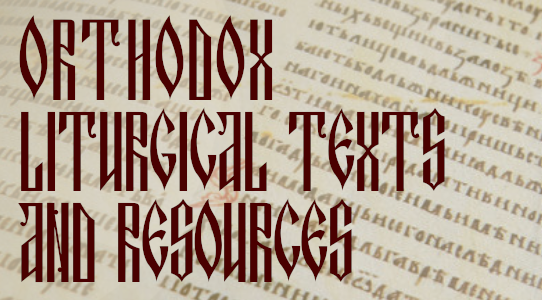Before you go any further, there are a few points that need to be understood about Chinese Orthodox texts. 100 years ago, essentially every liturgical text had been translated into what was at the time standard literary Chinese (now known as Classical Chinese). Many of these texts (if not most) still exists, but unfortunately a few things have happened to the Chinese language since that time. First of all, in the wake of the Nationalist Chinese revolution, Classical Chinese began to give way to modern Chinese. When the Communists took over mainland China, they further revised the writing of Chinese characters into what is known as Simplified Characters.
So there are three kinds of Chinese texts that must not be confused:
- Classical Chinese texts written in Traditional Characters (and now on one web site, also Simplified characters)
- Modern (or relatively modern) Chinese texts in Traditional Characters
- Modern Chinese texts written in Simplified Chinese Characters
There are many Chinese texts in Classical Chinese, but unless one is a Chinese scholar, most Chinese will find these of very limited use. Their primary use at this point is for those few individuals in the world today who have both the ability and the willingness to revise these texts into more usable Chinese. To be clear on this point: the difference here is not like that between King James English and contemporary English. Classical Chinese can be read with understanding by only the most educated Chinese, and when it is read aloud, it is even more incomprehensible – which means these texts cannot possibly be used for liturgical purposes. This is the kind of Chinese found in the little Chinese prayer book reprinted by Holy Trinity Monastery in Jordanville, New York.
From beginning of the 20th century up until the time of the Cultural Revolution, there were a number of Chinese texts published that use what is more or less Modern Chinese. There was a Catechism published in the early 20th century. A prayer book published in the 30’s. And many other books, including the Horologion and the Octoechos which were printed after the Communist Revolution, but prior to the Cultural Revolution. None of these texts are currently in print, but are being used to produce revised texts. Some of these texts are available in provisional forms – please e-mail me for more information. These texts are all in Traditional Characters, and so would be of more use to older Mainland Chinese, or those from Taiwan or Hong Kong than it would for younger people from the PRC. However, even younger Mainland Chinese can usually work their way through Traditional Characters – it is just a lot harder, and so the utility of such texts would depend a lot on the level of determination of the user.
At present there is an effort to produce revised Chinese texts, and many of these texts are being made available in Simplified Characters. This is the best format for those from the PRC. Chinese from Taiwan, Hong Kong or those in the Chinese Diaspora have about the same difficulty with Simplified texts as those from the PRC have with Traditional Characters.
In short, if you are looking for Chinese Orthodox material for some one you know, you need to take into account where they are from, and you need to ensure that you are getting texts that they will have a chance at understanding.
Orthodox Material in Chinese
- Orthodox Christianity Bookstore and Library
- Chinese Liturgical Texts
- Chinese Prayer Books
- Orthodoxy in China: Classical Chinese Texts, but in Simplified Characters
These texts are hosted by the Moscow Patriarchate, but as noted above, are of unfortunately limited use for most Chinese.
- Morning Prayers in Chinese and English
- Articles about the Orthodox Faith in Chinese
- The Prologue from Ohrid
- A homily on Nativity in Chinese and English
- The Bible in Chinese, with a New Testament text that matches the Traditional text of the Church (Simplified Characters)
Chinese Orthodoxy
- Orthodoxy in China
- The New Martyrs of China
- The Christian names of the Chinese Martyrs of the Boxer Rebellion
- Orthodoxy in China (Sponsored by the Moscow Patriarchate)
- Holy Resurrection Orthodox Church, in Singapore

The Hieromartyr Mitrophan


